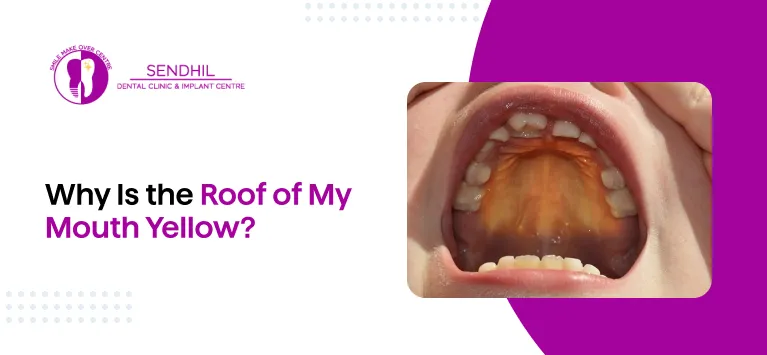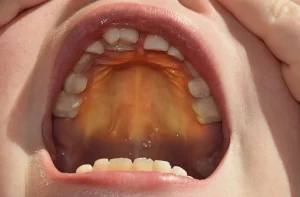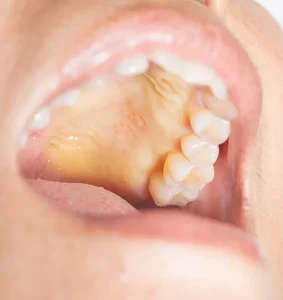
Why Is the Roof of My Mouth Yellow?
A yellow roof of the mouth can be caused by various factors, ranging from harmless conditions like dehydration to more serious health issues like jaundice or infections. The discolouration may appear as a result of bacteria, medications, smoking, or even a vitamin deficiency. In this blog, we will explore the common causes of a yellow roof of the mouth, the symptoms associated with it, and when you should seek medical attention. We’ll also discuss home remedies that may help reduce discolouration and improve oral health.
Table of Contents
Pictures of Yellow Roof of Mouth
Here are some pictures pictures of yellow roof of mouth. However, always consult a dentist or doctor for a proper diagnosis.


Common Causes of a Yellow Roof of Mouth
A yellow roof of the mouth can be caused by various factors such as jaundice, oral thrush, smoking, dehydration, bismuth-containing medications, infections, oxidising mouthwashes, vitamin deficiencies, or burns. Here are the common causes and their symptoms:
Jaundice
Jaundice occurs when there’s a buildup of bilirubin in the body, leading to yellowing of the skin, eyes, and mouth. The yellow soft palate (roof of mouth) can be one of the first signs. If you also notice yellow eyes or skin, it’s important to see a doctor.
Symptoms:
- Yellow skin and eyes
- Fatigue
- Dark urine
Oral Thrush
Oral thrush is a yeast infection that can cause white and yellow patches in the mouth. If the roof of mouth white and yellow patches, it might be due to this condition.
Symptoms:
- White or yellow spots
- Sore mouth
- Difficulty swallowing
Smoking and Tobacco Use
Smoking can irritate the mouth, causing discoloration. The inside roof of mouth is yellow due to tobacco staining.
Symptoms:
- Yellow patches
- Bad breath
- Dry mouth
Dehydration
Dehydration can make the roof of your mouth look yellow because of dry tissues and reduced saliva.
Symptoms:
- Dry mouth
- Thirst
- Cracked lips
Medications Containing Bismuth
Certain medications like bismuth subsalicylate, found in Pepto Bismol, can cause a yellow roof of mouth. This happens when bismuth reacts with sulfur in the mouth, leading to discolouration of oral tissues, including the tongue and palate.
Symptoms:
- Yellow or black coating on the tongue
- A yellow tint on the roof of the mouth
- Metallic taste
Infections (Cold or Sore Throat)
A throat infection can make the roof of mouth sore and yellow. If you ask, “Why is the roof of my mouth yellow and my throat sore?” then it might be linked to an infection.
Symptoms:
- Sore throat
- Swollen glands
- Fever
Oxidizing Agent Mouthwashes
Mouthwashes with oxidizing ingredients, such as hydrogen peroxide, can make the roof of mouth looks yellow. The oxidation process can temporarily affect the colour of the tongue and palate, especially with frequent use.
Symptoms:
- Yellow or white patches in the mouth
- Mild irritation or dryness
- Temporary change in taste
Vitamin Deficiency
A lack of certain vitamins, like B12, can lead to a yellow roof of mouth. Vitamins help keep tissues healthy.
Symptoms:
- Fatigue
- Pale skin
- Tongue soreness
Injury or Burns
Eating hot foods can burn the top of mouth is yellow area. Burns or injuries might cause temporary yellowing.
Symptoms:
- Pain
- Swelling
- Blisters
Yellowish Roof of the Mouth and Associated Symptoms
A yellow roof of the mouth can sometimes signal an underlying condition, especially if other symptoms accompany it. Below are possible combinations of symptoms and their potential causes:
Roof of Mouth White and Yellow
Oral thrush, caused by a fungal infection, often presents as yellow and white patches on the roof of the mouth. Another potential cause is leukoplakia, which leads to white patches in the mouth. This condition requires medical attention as it may develop into oral cancer.
Roof of Mouth is Yellow with Red Spots
Red spots combined with a yellow roof of the mouth could indicate oral herpes. Depending on the outbreak’s stage, these lesions may appear as red blisters containing yellow pus. Hand, foot, and mouth disease can also cause red spots on the roof of the mouth due to viral infection.
Roof of Mouth is Yellow with a Sore Throat
A sore throat paired with a yellowish roof could be due to oral thrush spreading to the esophagus, leading to esophageal thrush. Pharyngitis or strep throat, which are infections of the throat, can also cause difficulty swallowing. The buildup of bacteria from these infections may turn the roof of the mouth yellow.
Strep Throat and Yellow Roof of Mouth
Strep throat, a bacterial infection, can lead to a yellow roof of the mouth due to the accumulation of bacteria and pus. Inflammation and irritation caused by the disease may result in difficulty swallowing and discomfort. The yellow discoloration may also extend to the tonsils and back of the throat, especially when the disease is severe.
Home Remedies for Yellow Roof of Mouth
If you have a yellow roof of the mouth, there are several natural remedies you can try to help reduce discolouration and improve oral health. These remedies include good oral hygiene, honey and warm water, salt water rinse, apple cider vinegar, coconut oil, turmeric powder, clove oil, lemon juice rinse, and proper hydration. Here’s how each one works:
Good Oral Hygiene:
- Regular brushing of the teeth and the roof of the mouth with fluoride toothpaste is crucial for removing plaque and preventing bacterial buildup, which can contribute to yellowing.
- Use a soft-bristled toothbrush to avoid irritation and clean the roof of your mouth gently for best results.
Honey and Warm Water:
- Honey has antibacterial and anti-inflammatory properties that can soothe the mouth and reduce bacteria.
- Mix one tablespoon of honey in warm water and rinse your mouth to help clean and hydrate the area, potentially reducing yellowing.
Saltwater Rinse:
- Saltwater acts as a natural disinfectant and helps reduce inflammation and bacteria in the mouth.
- Gargle with warm salt water 2-3 times a day to cleanse the mouth and potentially improve discoloration.
Also Read: https://www.sendhildental.com/5-benefits-of-salt-water-on-dental-health/
Apple Cider Vinegar:
- The acidic properties of apple cider vinegar help break down buildup in the mouth and remove stains.
- Mix one teaspoon of apple cider vinegar with a glass of warm water and use it as a mouth rinse. Rinse with plain water afterwards to protect your teeth from enamel erosion.
Coconut Oil:
- Oil pulling with coconut oil helps remove bacteria and plaque, which can cause discolouration.
- Swish one tablespoon of coconut oil in your mouth for 10-15 minutes, then spit it out. This practice is believed to improve overall oral health and reduce yellowing.
Turmeric Powder:
- Turmeric has anti-inflammatory and antimicrobial properties that can help brighten the roof of the mouth.
- Make a paste by mixing turmeric powder with water or coconut oil and gently apply it to the roof of your mouth. Leave it on for a few minutes before rinsing thoroughly.
Clove Oil:
- Clove oil has antibacterial, antifungal, and soothing properties. It can reduce bacterial buildup and discomfort in the mouth.
- Dilute a few drops of clove oil in a carrier oil (such as coconut oil) and gently massage it onto the roof of your mouth. You can also mix a drop of clove oil with water for a mouth rinse.
Also Read: https://www.sendhildental.com/clove-oil-for-teeth-and-gums/
Lemon Juice Rinse:
- Lemon juice has natural acidic properties that help remove surface stains and promote saliva production.
- Mix the juice of half a lemon with a glass of warm water and use it as a mouth rinse. Be cautious not to overuse it, as lemon juice can erode tooth enamel over time.
Hydration:
- Drinking plenty of water throughout the day helps keep the mouth hydrated and flushes away food particles and bacteria that may contribute to yellowing.
- Staying hydrated also prevents dry mouth, which can worsen oral health issues and discoloration.
How to Get Rid of Yellow Roof of Mouth?
If you’re looking for how to get rid of the yellow roof of mouth, it depends on the cause. Here are some simple steps:
- Stay Hydrated: Drink plenty of water to keep your mouth moist.
- Practice Good Oral Hygiene: Brush and floss regularly.
- Avoid Smoking: Quitting smoking can reduce yellowing.
- See a Doctor: If it’s due to an infection or jaundice, medical treatment is needed.
- Eat a Balanced Diet: Ensure you’re getting enough vitamins.
Is Yellow Roof of Mouth Normal?
A yellow roof of the mouth is not normal but is often not serious. While temporary discolouration can occur due to factors like certain foods, medications, or mouthwashes, persistent yellowing may indicate an underlying condition such as oral thrush, bacterial infections like strep throat, or even poor oral hygiene. Suppose the yellow colour does not resolve or is accompanied by other symptoms like pain, sores, or a sore throat. In that case, it’s important to consult a doctor for proper evaluation and treatment.
When to See a Doctor
Consider seeing a doctor if a yellow roof of the mouth:
- Lasts more than a few days without improvement.
- It is accompanied by persistent pain, swelling, or redness, which could indicate an infection.
- Includes white patches or thickened areas, which may suggest conditions like oral thrush or leukoplakia.
- Comes with a sore throat, fever, or difficulty eating/drinking, potentially pointing to strep throat or pharyngitis.
- Involves blisters or sores, especially if they are painful or filled with pus, as seen in oral herpes.
For Enquiry, Call Us: +91-9600091767
Conclusion
While a yellow roof of the mouth is often not serious, it can sometimes signal an underlying health issue. If the yellowing continues or is accompanied by additional symptoms such as pain, swelling, white patches, fever, or difficulty swallowing, it’s important to take action.
Key factors to keep in mind include:
- Persistent yellowing that doesn’t improve
- Pain, swelling, or redness in the mouth
- The appearance of white or yellow patches
- Difficulty swallowing, a sore throat, or fever
If you’re experiencing any of these symptoms, it’s best to consult a healthcare professional. For a proper diagnosis and treatment plan, contact Sendhil Dental Care for expert guidance and care.




